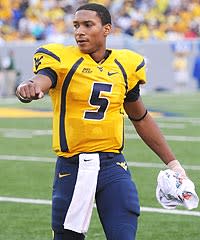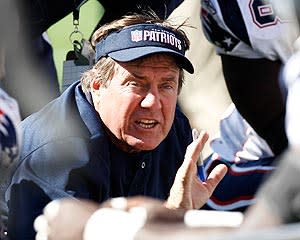The potential steal of the NFL draft
All the big football powers of the Southeast had come to watch Pat White at Alabama's Daphne High School. Why wouldn't they? The kid was a natural athlete, quick and shifty, someone who would eventually get drafted three separate times by Major League Baseball.
White was an exciting quarterback but the college recruiters envisioned something different – a wide receiver, a cornerback, a tailback. He wound up committing to LSU to catch passes.
Only one major school had always seen him as a QB – West Virginia.
"I told my assistants, ‘This is a quarterback, not an athlete who plays quarterback,' " said then-West Virginia coach Rich Rodriguez, whose belief in White got the playmaker to switch from LSU and sign with the Mountaineers. "You could see how he managed the game.
"We obviously ran the spread," Rodriguez continued, "but I would've taken him for any system. I didn't have any questions about him at all."
White went on to a brilliant career, the first starting quarterback to win four bowl games.
For White's sake, it would have been preferable if Rodriguez had wound up coaching in the NFL and not at the University of Michigan because five years later he's dealing with the same doubts about his position.

Pat White finished his career at West Virginia as college's first starting quarterback to win four bowl games.
(Jeff Gentner/AP Photo)
It makes White one of the most intriguing prospects in Saturday's NFL draft. Everyone loves a second-guessed underdog who will show up the system. Everyone loves criticizing the NFL's Neanderthal group-think about the size and strength of what makes a player.
Here's the thing, though. White may still be dealing with old stereotypes about prototypical size and skill sets. He may also be entering a rapidly changing league where, thanks to New England's Bill Belichick (and his expanding influence), multi-skilled, multi-position players are more valuable than ever.
Combine that with the offense du jour – the Wildcat, which features some principles of the spread offense and has revolutionized the college game – and White may find he's in demand not in spite of his unorthodox quarterback abilities, but because of them.
That may not make him your typical franchise quarterback, such as Georgia's Matthew Stafford or USC's Mark Sanchez, but he could be the steal of the draft. His selection offers a referendum on just how much the league and its thinking have changed.
"I've told the NFL guys he's got the 'it' factor that all the great quarterbacks have," Rodriguez said. "The bigger the stage the better he plays. And he can make all the throws. He may not be tall, but he has a high release. If someone just gives him a real chance there's no question he'll be [successful]."
His old coach's support aside, White won't be handed the keys to a franchise. His star turn with the Mountaineers, his Senior Bowl MVP (as a QB) and his head-turning performance at February's combine, where he threw better than anyone else, can't overcome his 6-foot, 197-pound frame or his rep as a running quarterback.
Just like back in high school, many football people project him as a receiver or running back, anything but QB.
Yet White is a "football player." If you get lost in the particulars, you lose sight of that. Increasingly, though, the NFL is hiring people that don't fall into that trap.

"Bill Belichick [above] knows exactly what he’d do with someone like Patrick White," said WVU coach Bill Stewart.
( Winslow Townson/AP Photo)
With new, New England-linked regimes in Kansas City, Denver and Cleveland, plus the original still perched up in Foxborough, the Belichickization of the NFL is well under way.
That's 12.5 percent of the league alone and doesn't count less direct, yet not insignificant, ties to BB in places such as Atlanta, Baltimore, Detroit and elsewhere.
Belichick has been coaching in the NFL longer than anyone (since 1975, when he became a 23-year old assistant with the Baltimore Colts). He has won three Super Bowls, put together just the second perfect regular season in league history and found ways to field winning teams with unlikely personnel decisions.
Belichick loves "football players." He's into generalists, not specialists, guys who can play two or three positions and make the most of their spot on the 53-man roster. He likes defensive players he can use to block like fullbacks and wide receivers that can double as cornerbacks.
He most famously used linebacker Mike Vrabel in short yardage receiving situations, the 6-4, 260-pound defender catching eight career TD passes, including one in a Super Bowl.
It's little surprise that Belichick brought White in to work out and has discussed the player with current WVU coach Bill Stewart. With Tom Brady, New England doesn't need a quarterback; yet according to Stewart, the team isn't just interested in White as a receiver. They appreciate the total package of skills, including taking snaps directly.
"Bill Belichick knows exactly what he'd do with someone like Patrick White," Stewart told the Boston Globe. "He finds a way to put the ball in the hands of a winner.
"The Bill Belichicks, Mike Tomlins, Bill Parcellses, those guys that know winners – winners, not 750-page playbooks – find places to put them. That's what I've told the NFL guys. You want him to be a slot? He'll drive defenses nuts. He could also be a force with the Wildcat."
Most mock drafts have White going in the third round. It says here he doesn't last that long. There are too many Belichick disciples out there, too many coaches intrigued by the spread, who see Pat White for not just what he can do, but what he represents in terms of roster freedom and potential.
White says he's willing to do anything a team asks him to do, but reminds that he wants to be an every down quarterback. Rodriguez, for one, thinks a smart team builds a system around him.
Rodriguez may be right, but White is too valuable to spend a season or two holding a clipboard, which is the fate for most rookie quarterbacks.
He's a football player, after all, not just a prototype quarterback – a potential changing era in the NFL that may actually be a positive.
